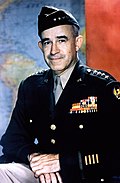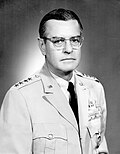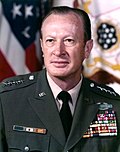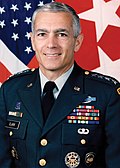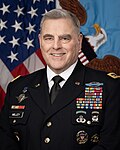| Legislation | Citation | Summary |
|---|
| Act of March 3, 1799 | 1 Stat. 752 | |
| Act of July 25, 1866 | 14 Stat. 223 | |
| Act of March 1, 1869 | 15 Stat. 281 | - Authorized brevet ranks for distinguished conduct and public service in presence of the enemy (Tasker H. Bliss) [repealed in 1956 (70A Stat. 642)].
|
| Act of March 3, 1885 | 23 Stat. 434 | - Authorized rank and full pay of general on the retired list for Ulysses S. Grant.
|
| Act of June 1, 1888 | 25 Stat. 165 | |
| Act of October 6, 1917 | 40 Stat. 410 | |
| Act of September 3, 1919 | 41 Stat. 283 | |
| Act of February 23, 1929 | 45 Stat. 1255 | - Increased rank of chief of staff of the Army to general.
|
| Act of June 21, 1930 | 46 Stat. 793 | - Authorized promotion on the retired list or posthumously to highest grade held during World War I, with no increase in retired pay (Tasker H. Bliss, Peyton C. March).
|
| Act of December 14, 1944 | 58 Stat. 802 | |
| Act of August 7, 1947 [Officer Personnel Act of 1947] | 61 Stat. 886 | - Authorized president to designate, subject to Senate confirmation, Army officers to have the rank of general while assigned to positions of importance and responsibility.
- Capped Army positions with ranks above major general at 15 percent of the total number of general officers serving on active federal military duty, of which not more than 25 percent to carry the rank of general.
|
| Act of June 26, 1948 | 62 Stat. 1052 | - Authorized permanent grade of general and full active-duty pay and allowances in retirement for Omar N. Bradley.
|
| Act of September 18, 1950 | 64 Stat. A224 | |
| Act of October 11, 1976 | 90 Stat. 2078 | |
| Act of December 12, 1980 [Defense Officer Personnel Management Act] | 94 Stat. 2844
94 Stat. 2849
94 Stat. 2876 | - Authorized president to designate positions of importance and responsibility to carry the grade of general, to be assigned from officers on active duty in any grade above colonel, subject to Senate confirmation, who revert to their permanent grade at the end of their assignment unless it was terminated by
- assignment to another position designated to carry the same grade,
- up to 180 days of hospitalization, or
- up to 90 days prior to retirement [reduced to 60 days in 1991 (105 Stat. 1354)].
- Capped, except during war or national emergency, Army officers in grades above major general at 15 percent of all general officers on active duty, of whom not more than 25 percent to serve in the grade of general.
- Authorized three- and four-star officers to retire in the highest grade held on active duty, at the discretion of the president and subject to confirmation by the Senate, with no time-in-grade requirement [changed in 1996 to certification by secretary of defense and three-year time-in-grade requirement (110 Stat. 292)].
|
| Act of January 28, 2008 | 122 Stat. 496 | - Increased grade of chief of the National Guard Bureau to general.
|
| Act of October 28, 2009 | 123 Stat. 2273
123 Stat. 2274
123 Stat. 2276 | - Capped Army officers in the grade of general at 7, exempting from caps the chief of the National Guard Bureau and up to 20 generals assigned to joint duty [joint-duty cap repealed in 2016, effective December 31, 2022 (130 Stat. 2100); caps changed in 2021 to 8 Army generals and 19 joint-duty generals (134 Stat. 3563)].
|
| Act of December 23, 2022 | 136 Stat. 2611 | |
| Act of December 22, 2023 | 137 Stat. 244 | - Increased grade of vice chief of the National Guard Bureau to general.
|
|























